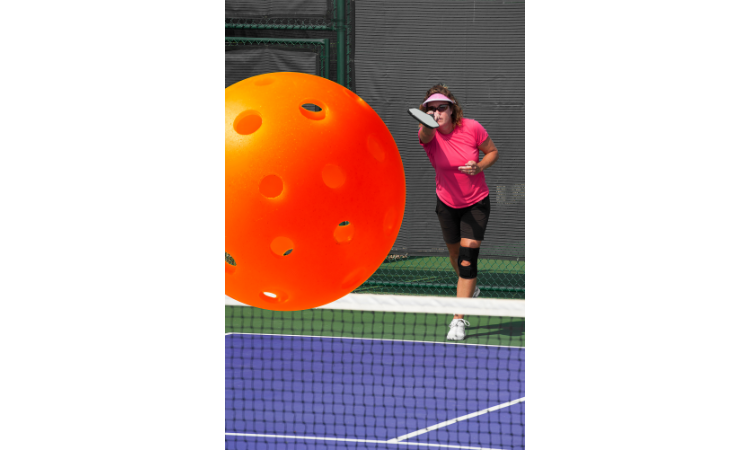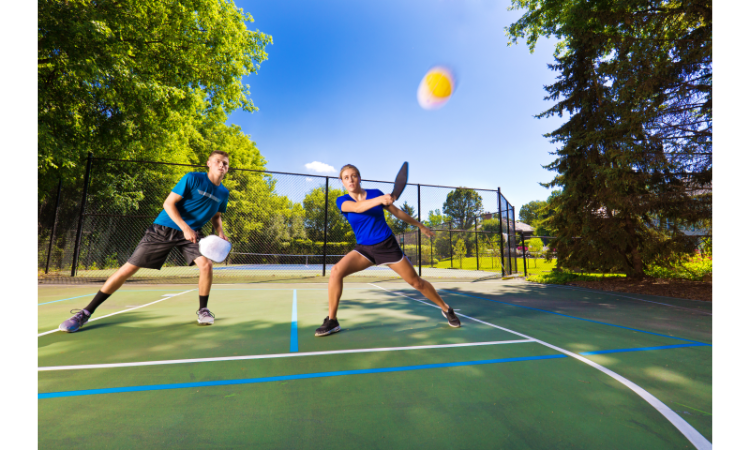Pickleball is an addictive game because it’s easy for beginners to pick up and play. But it’s important to understand the pickleball rules, especially the 2 bounce rule.
The 2 bounce rule separates pickleball from your traditional racket sports like tennis, so when people transition from tennis to pickleball, the 2 bounce rule throws people off their game a bit. But when you learn the 2 bounce rule in pickleball, you can start strategizing around it and use it to your advantage.
What is the 2 Bounce Rule in Pickleball?
The 2 bounce rule in pickleball states that the ball must bounce once on each side of the court before either team can volley out of the air. For example, when the serving side serves the ball, the returners must let the ball bounce before hitting it. Then, the serving side has to let the ball bounce before they return it.

If a player volley’s off of the serve or the return, this is called a “pickle” and results in a fault. When the returner volleys the ball out of the air off of the serve, the serving team can choose to stop play and add a point to their score. And if the serving side volleys the ball off of the return, the returners can stop play and call a “fault”.
Why is the 2 Bounce Rule in Pickleball Important?
While many tennis players may roll their eyes at the 2 bounce rule in pickleball because they want to volley off of a good serve, this rule actually promotes fairness and safety; not to mention it makes the points longer and more entertaining.
Because the player has to hit the serve underhand at an upward trajectory and clear the kitchen line, the returning side would have an unfair advantage if they could simply volley the ball out of the air for a winner. This is why the ball must bounce on the returners side off of the serve.
The same concept goes for the serving side. If a player can serve and volley, it would be too easy to score points, especially since only the serving side can score. The 2 bounce rule in pickleball gives each side the fairest advantage based on the pickleball rules set in place.
It’s also important to note that the 2 bounce rule is set in place for safety reasons. Since the strategy is to get to the kitchen line and play close to the net, the 2 bounce rule encourages more time for players to work the point before they can come up to the kitchen line to volley.
Returner Side Pickleball Strategies Based on the 2 Bounce Rule
Now that we understand the 2 bounce rule in pickleball, how do we use this to our advantage? From a returner’s perspective, this rule allows for an easier offensive strategy. Use the following expert tips in your next gameplay!

1. Return the Ball Deep in the Court
Because the server can’t hit the ball until it bounces, returning the ball deep either forces their opponents to hit their third shot behind the baseline or off their back foot. This makes their third shot drop harder to hit in the kitchen, or their drive less impactful.
2. Loft the Return Deep
Because the serving side is forced to wait to hit the ball based off of the 2 bounce rule in pickleball, you can aim higher over the net to get the return deep AND give yourself time to get to the kitchen line.
The ideal offensive scenario is for you and your partner to be at the kitchen line while your opponents are both back at the baseline. This gives you more area of the court to work with and since you and your partner can volley first, your shots take time away from your opponent to set up for the next shot.
3. Aim to the Weaker Side of Your Opponent
For the majority of players, their backhand is usually the weaker stroke. Place your return to your opponent’s weaker side so you can be in an offensive position at the kitchen line.
4. Mix in Different Spins on Returns
The 2 bounce rule in pickleball gives you the advantage of using different spins to trip up your opponent. Try adding in underspin or topspin returns.
You’ll need to adjust your grip based on the type of spin you want, so be sure to decide what spin to use before the serve bounces on your side.
5. Stand Behind the Baseline to Return Serve
If your opponents are hitting their serves deep, the best strategy is to start behind the baseline so you can step into the return. When your body weight is going forward on impact, you’re using your momentum to hit the ball harder and moving forward toward the kitchen line. It’s a win-win!
Server Side Pickleball Strategies Based on the 2 Bounce Rule
If you or your partner is serving, your goal should be to get to the kitchen line as fast as possible. Getting to the kitchen line gives you and your partner a 50/50 chance of winning the point because now all four players are in an offensive position.

But because the 2 bounce rule in pickleball doesn’t allow you to volley off the return, you and your partner are at a slight disadvantage. Try these expert tips to counteract the return and put yourself in a better position to get to the kitchen line.
1. Hit Your Serve Deep
Serving deep in the court is one of the best strategies to counteract a tough return. The deeper the serve, the tougher it is for the returner to hit deep.
Your goal as the server is to force the return short so you’re closer to the kitchen line after hitting a third shot.
2. Mix in Different Serve Speeds
Irina Tereschenko, a professional pickleball player, is known to throw in a high serve every now and then in hopes to create a weaker return a neutralize the 2 bounce rule. Mixing up the pace of serves can throw off the returner’s rhythm and force an error.
Try mixing in a drop serve where the ball lands right over the non-volley line. This slower serve makes it tough for the opponent to return it back, especially if they are anticipating a harder, deep serve.
3. Hit a Third Shot Drive
If a return is hit deep, one option to create a shorter ball on the fifth shot is to drive (a forehand or backhand groundstroke) the third shot. It’s tough to land your third shot drop in the kitchen from far behind the baseline.
4. Try the “Shake and Bake”
The “Shake and Bake” strategy is when one player hits a third shot drive while their partner crashes the kitchen line and volley’s the fifth shot. This works when one person has a really strong drive that forces their opponent to pop the ball up.
Ben Johns and Anna Leigh Waters, the number one mixed doubles team in the world, are notorious for doing the “Shake and Bake”.
Pro Tip: If you’re seeing topspin or underspin returns and are struggling to hit a solid drive, invest in a pickleball machine to work on counteracting different spins.
































